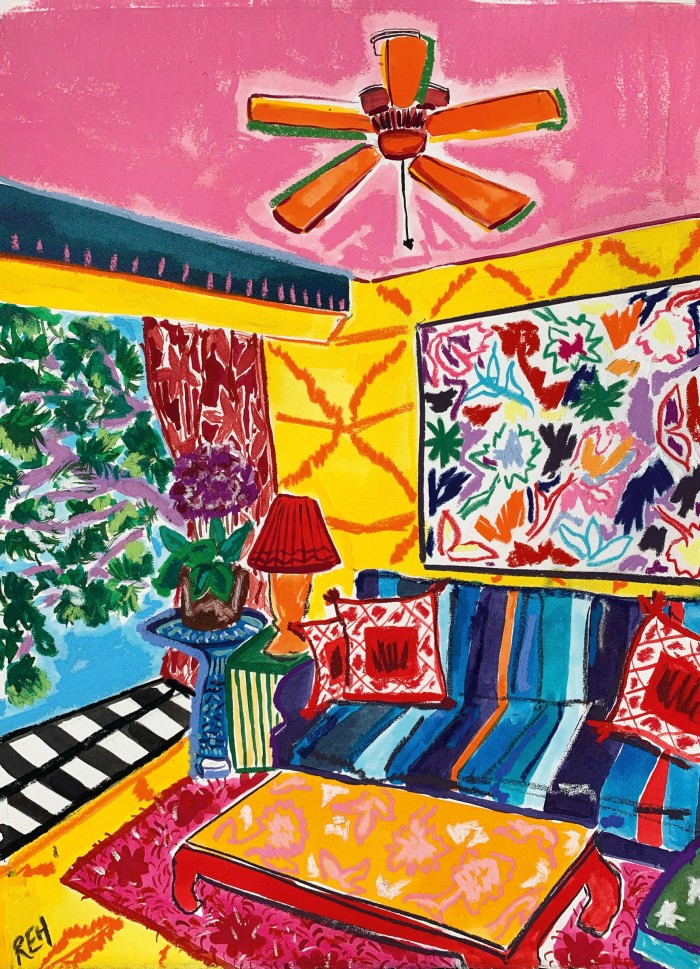Ministers of the interior: the radical reinvention of the domestic portrait

Simply sign up to the Life & Arts myFT Digest -- delivered directly to your inbox.
Enter the domestic interior: a genre of painting that treats a room as its subject, rather than just a backdrop. Though long relegated to the draughty back rooms of art history, the idea that our homes and how we furnish them matter enough to merit artistic attention is age-old. Think, for example, of the bold simplicity of Van Gogh’s blue bedroom in Arles. Paintings can hold a mirror to how we live. So it’s no surprise that now, when we find ourselves shuttered inside the same four walls, the domestic interior is enjoying an Insta-revival, with a new generation of artists succumbing to its charms.
Nosing around people’s homes has been a middle-class obsession ever since the concepts of comfort and cosiness first crept into households in the late 18th century. Soft furnishings and wallcoverings became arbiters of social status, and not just for the elite.


Brighton designer-illustrator Emily Maude creates joyful works on glass and paper inhabited by jolly Staffordshire dogs and lustreware jugs (often discovered on trips to Ardingly Antiques Market in West Sussex) set against the patterns of antique French wallpapers. In an effort to curtail her own collecting habit – she’s on a self-imposed ceramics-buying ban – her art imagines spaces much larger than her home, and ones she can endlessly fill with wonderful things.
It was while on furlough from her role as a retail buyer at Westminster Abbey and unable to visit her family that her focus shifted towards the domestic. “The need to explore the home comes from feeling disconnected,” she says. “For me, looking at these objects is both grounding and an escape.”
A similar feeling of discombobulation compelled Sarah-Jane Axelby, a one-time publisher with a degree in textile design, to start sketching the rooms she longed to visit. In the midst of training to become an interior decorator and forced to shield from the virus, Axelby sought solace in the pages of decoration magazines. What began with a simple sketch of her own sitting room evolved into daily social posts of her favourite spaces, landing her with a slew of private commissions from designers and clients – including designer-hotelier Kit Kemp – and a whole new career.


“I wanted to be in these spaces and historic homes, and to escape from the realities of what was going on,” she says. Her @sjaxelby account is a roving taste tour filled with colour and tinged with nostalgia. When rendered in paint and pen, these rooms take on a vivid new life. From the red-striped Tangier riad of designer Gavin Houghton to the Gran Canaria bolthole of the late, legendary editor Min Hogg, Axelby’s work is an unadulterated celebration of English decoration in all its visual glory.
For Rowena Morgan-Cox, the former managing director of The Fine Art Society, there are powerful parallels between the early rise of the domestic interior in art and today. “During the Industrial Revolution, the home became a protective shield around people,” she says. “With the pandemic and so much economic uncertainty, the interest in interiors has gone beyond rooms just looking pretty. It’s about shielding and veiling us in uncertain times.”


The gallery has strong links to the genre through artists such as Whistler, who was one of the first to show his works there, while at its new Soho headquarters art is displayed in a deliberately homey setting. Morgan-Cox believes tastes for political work are waning. She suggests her clients are responding to softer, gentler, uncomplicated artworks – and the upholstered prettiness of the domestic interior is an answer to that call.
“The home in art is a safe space both figuratively and metaphorically,” says Los Angeles artist Alec Egan, whose own seductive home scenes come from a rich West Coast tradition in which David Hockney – picking up the conversation from Matisse, among others – looms large (indeed, Hockney’s portrait Henry Geldzahler and Christopher Scott depicts a large pink sofa). “At the moment, we’re scrutinising our environments and they start to become this all-consuming space,” he says. It’s a mindset that Egan likens to a teenager’s bedroom – one chamber that comes to represent an entire world.
Egan’s exhibitions each depict a single room of an imaginary house he’s slowly constructing, with a central canvas displaying the whole space, alongside a constellation of smaller works forensically depicting its details. A riot of pattern and tone, these fantasy spheres are nonetheless rooted in the familiar. Memories of the faded chintz of his grandparent’s Iowan home get a powerful psychedelic makeover. Filled with cryptic clues to its inhabitants, it invites us to imagine: who lives in a house like this?
British artist Lottie Cole conveys a similar impulse. “I try to think about who the room is owned by and how they would decorate it,” she says. “Then I go on an imaginary shopping spree.” Cole’s painterly pieces are peppered with nods to art history – Henry Moore sculptures, Christopher Wood canvases, Eileen Gray chairs – many of which are pulled from a huge cache of auction catalogues inherited from a Tate-curator friend. “There’s something very modest about an interior,” concludes Cole. “And what it can reveal about what’s going on in people’s lives.”
Comments